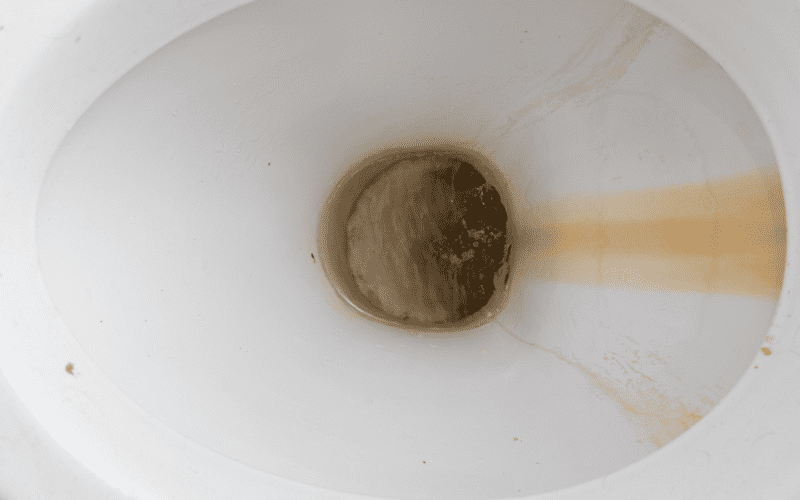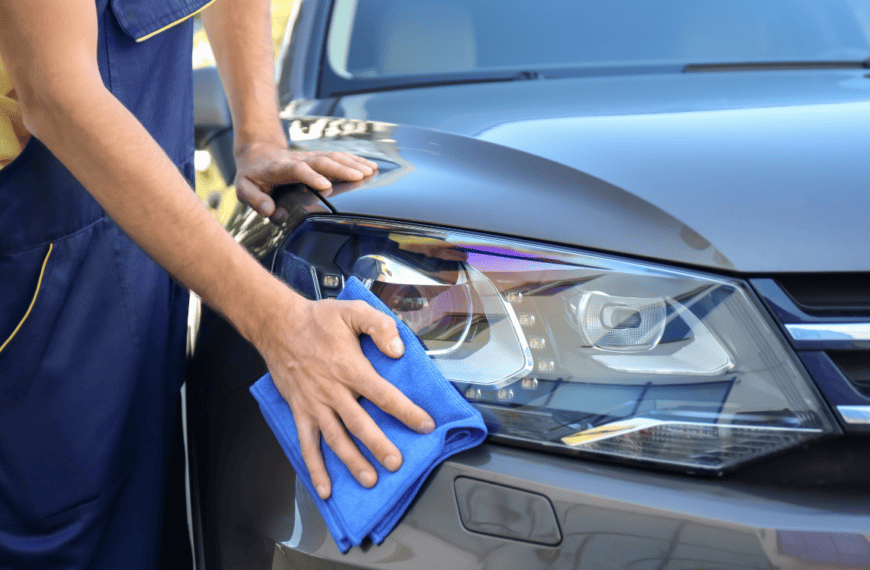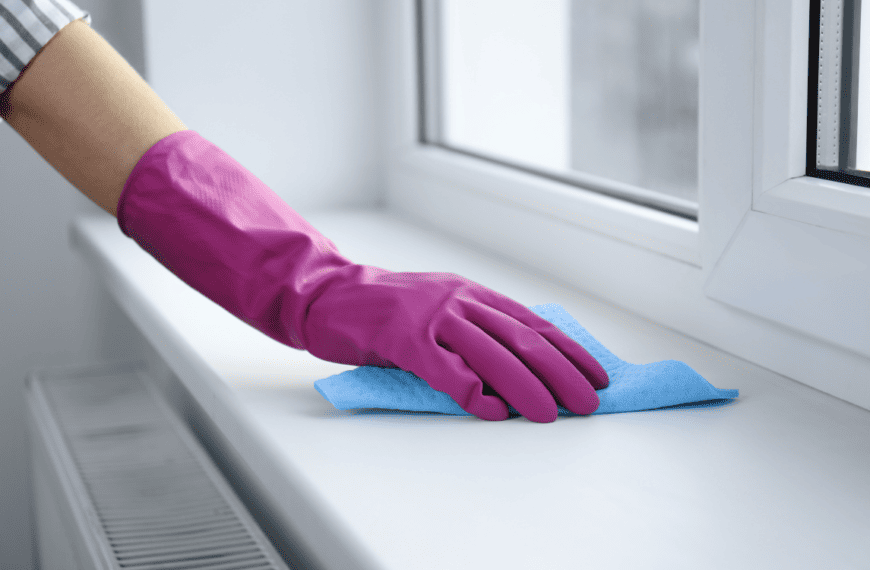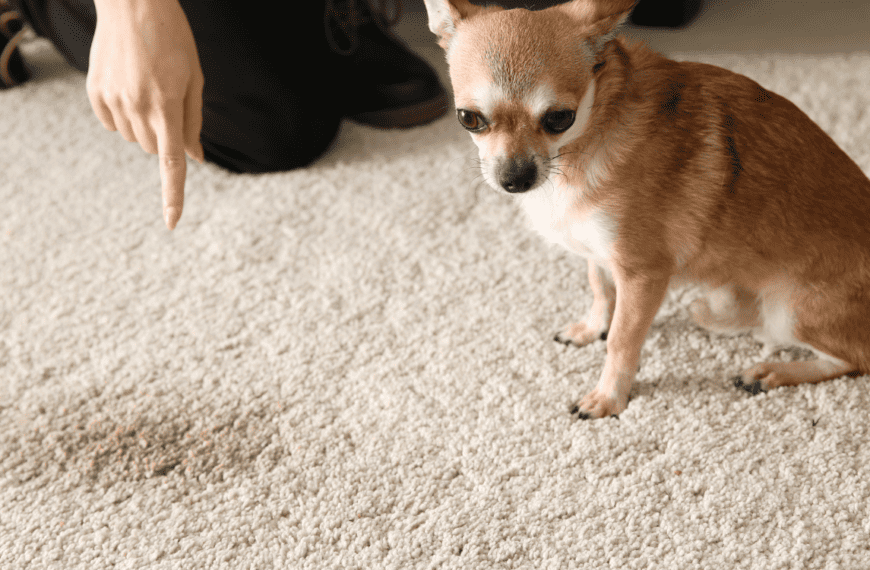We do not have a whole home water softener, and with the water here being a little harder, rust stains are something we deal with continually. Just last year, we had our bathroom remodeled, and in less than 6 months, there were terrible rust stains in our clean toilet. I’ve become an expert on how to remove rust in toilet bowls simply from having too much practice. I’ll show you what works, what doesn’t, and how you can (try to) prevent it.
Rust in Toilet Bowl (What, Where, Why, When, and How!)
Rust in a toilet bowl looks like someone forgot to use the toilet brush when they were finished using the bathroom! Most of the time, you see an orange/brown colored stain, and it can occur along the rim of the toilet or even down at the bottom of the bowl near the drain.
The reason you get rust is that there is iron in your water supply that mixes with the oxygen in your water. The iron oxide that is created is the rust that is left behind.
If rust seems to be a recurring issue for you, it’s likely because of one of the following issues:
- Old pipes that have built-up iron along the insides
- Hard water or well water and no water softener system or water filtration system
- High levels of iron bacteria and iron particulates in the water
Rust stains aren’t like other stains in that they don’t simply need a whitening to release and flush down the toilet. You have to find something with enough acid and grit to actually break down the rust. If not, your toilet bowl stains will remain.
Precaution (Before You Begin Working On Your Stubborn Rust Stains)
When working to fight rust, make sure that you are using appropriate cleaning products. Toilet bowl and rust stains are two different things, so follow the methods carefully.
In addition, stay away from bleach when treating a rust stain in your toilet. In fact, you may cause the rust to spread, making this an even bigger project for yourself. I also would not use an abrasive scrubber, or you will be left with visible scratches.
Visible scratches are permanent; rust stains don’t need to be.
How To Remove Rust Stains From the Toilet Bowl
Here are my favorite methods for removing rust stains from the toilet. If you have rust stains in your toilet, you probably have them in your sink and tub as well. As long as the material is the same, you should be able to use these same methods to remove the stains.
Citric Acid
Citric acid is packed full of acidic properties that break down rust stains. You can use lemon juice as a replacement, but the powdered citric acid packs a bigger punch and has its own scrubbing power.
- Turn off the water supply to your toilet
- Flush the toilet several times so that you can access the rust stains.
- Pour citric acid on the stains
- Allow the citric acid to sit for 30 minutes
- Add a few cups of water to the toilet and scrub with the toilet brush
- Turn the water back on and flush until all citric acid powder has dissolved
- Repeat if necessary
Distilled White Vinegar
Distilled white vinegar is an acidic solution that can work on iron pipes and toilets without causing additional damage.
- Turn off the water to the toilet
- Flush the toilet so you have a relatively dry bowl with access to all rust stains
- Put distilled white vinegar in a spray bottle (undiluted vinegar is fine)
- Spray the vinegar on all of the rust stains
- Use a toilet brush with extra elbow grease to remove the rust stain
- If needed, sprinkle a little baking soda
Vinegar and Water Mixture
The vinegar and water mixture is the method I use on mild or new stains and even to prevent brown stains from occurring in the future.
- Flush the toilet
- Pour one to two cups of vinegar into the toilet bowl without draining it
- Let the vinegar and water mixture sit for a solid 30 minutes
- Scrub the toilet with the scrub brush
- Flush and repeat if necessary
Baking Soda and Vinegar Paste
Vinegar is great because of its acidic nature, but baking soda does a great job of breaking down tough bathroom stains. The combination of the two can be a great solution.
- Create a paste with three parts baking soda and one part water
- Put vinegar into a spray bottle
- Turn off the water supply to the toilet
- Flush until you have access to the rust stains
- While wearing gloves, put some baking soda and water paste on the rust stains, and let it sit for 30 minutes
- Come back to the toilet and spray the paste with vinegar
- Let this sit for an additional twenty minutes
- Use the toilet brush to scrub the mixture into the rust stains
- Turn the water back on, flush, and repeat if necessary
- This method is well-known and a good choice for those dealing with iron plumbing pipes that continually produce rust
Cream of Tartar
Cream of tartar is mildly acidic and non-abrasive, a good choice for toilet bowls.
- Turn off the water supply to the toilet
- Flush until the rust stains can be seen
- Apply cream of tartar and let it sit for 30-40 minutes
- Scrub with the toilet brush
- Turn the water back on, flush, rinse and repeat if necessary
Cola
Cola is used to remove rust, and I have it on my list because it does work. However, I’ll tell you that I don’t like the residue that it leaves behind, so I don’t use it in my own home. There is something much cleaner about baking soda, vinegar, or acetic acid of any type than Cola.
If you want to use Cola, simply drain the toilet, pour the Cola on the stains, let it sit, and then flush.
Pumice Stones
Pumice stones are created with naturally occurring volcanic rock; they work well on rust stains but choose something specifically geared at toilet bowls.
- Choose a pumice stone with a handle
- Wet the toilet specific pumice stone with water and start scrubbing the rust stains
- Sometimes I pull the stone out of the water, sprinkle it with baking soda, and put it back in
- Be careful that you don’t scrub so hard that you scratch the toilet
- Pumice stones can be used in toilet tanks for stains as well
Fresh Citrus Fruit and Table Salt
It may seem strange to bring half your kitchen ingredients into the bathroom, but you can trust me on this one; it will work.
- Turn off the water supply to the toilet
- Flush until the toilet is drained completely
- Squeeze fresh lemon juice or pour bottled lemon juice over the stain
- Sprinkle table salt into the toilet
- Use the toilet brush to scrub the lemon and salt into the rust
- Turn the water back on, flush, rinse and repeat
Commercial Rust Removers
I often start by attempting to remove stains using natural methods. However, with one of the older toilets in my home, cleaning rust stains seemed as though it was pointless until we tried a commercial rust remover.
Borax
If you are already using borax in your laundry room, you may as well use some for the bathroom. Borax is a strong cleaning agent and a good rust remover. It has just the right grit to scrub out the rust.
- Drain the toilet bowl so that you can sprinkle borax directly on the rust
- Pour borax on the stained surface
- Let the borax sit for a few hours
- Add a little water to the bowl and scrub the borax and water solution
Shaw’s Pads
Shaw’s Pads is a plumber’s best kept secret. Use this on your current and future stains to make cleaning a breeze.
- Purchase Shaw’s Pads with the handle
- Scrub the area with the toilet rust and even the ring around the toilet you may have
- Flush and repeat as often as necessary
Bar Keepers Friend
Bar Keepers Friend, in the powdered form, does a tremendous job on rusty bathroom surfaces. It has just the right amount of grit to get in there and remove those mineral deposits and get plumbing fixtures back to their original status.
- Drain the toilet and shut off the water supply
- Sprinkle the Bar Keepers Friend on the rusty surfaces
- Scrub with the toilet brush
- Add a little water if you need help scrubbing
- Turn the water back on, flush, and repeat
Clorox Toilet Bowl Cleaner Lime and Rust Remover
The Clorox Toilet Bowl Cleaner Lime and Rust Remover is a specific commercial cleaner designed to help tackle the iron in your water supply and keep rust from starting.
- Pour some Clorox Toilet Bowl Cleaner Lime and Rust Remover into the toilet bowl
- Use the toilet brush to scrub the areas with rust
- Let the solution sit for twenty minutes
- Flush and repeat until rust particles start to break down
How Often To Clean Rust Stains on Toilets, Tubs, and Sinks
The rust stains are easiest to deal with when they happen. If you are someone that uses bleach to clean your toilet bowls, you should treat your rust stains before using bleach in the toilet.
I would look for and treat rust stains at least once per month in homes that have issues with rust.
How To Remove Rust Stains From the Toilet Tank
The toilet tank has just as much exposure to water with high levels of iron as the toilet bowl. In addition, the toilet tank stays dark and moist at all times, so you can sometimes deal with mold and other bacteria in the tank.
- Drain the water out of the tank so that you have exposure to all of the rust stains
- Fill the toilet tank with vinegar; you will need about three gallons
- Take the toilet brush and scrub the sides of the tank with the vinegar
- Let the vinegar sit in the toilet bowl for a few hours
- Drain the vinegar by flushing the toilet
- Sprinkle baking soda on the inside of the toilet tank
- Scrub the toilet tank again
- Flush and see if the orange rust stains have disappeared
- If they are still there, you may consider using a commercial rust remover
Preventing Rust Stains in Your Toilet Bowl
To prevent rust stains, you can try any of these methods that I use. I will fully disclose that sometimes you just can’t prevent these rust stains; you just have to stay on top of treating them.
Clean the Toilet Regularly
The toilet gets cleaned with a toilet brush and a commercial or natural cleaning agent every few days in our house. I find that this helps prevent rust stains, but it certainly does not keep them away entirely.
Make Sure Your Toilet Does Not Continually Run
If you have a faulty flapper, your water will continue to run, making it very difficult to prevent rust stains. When things can stay as dry as possible, you will have fewer problems with rust.
Install a Water Softener
A water softener for the entire home is a great solution as it can help prevent rust stains in the toilet bowl but also in the sinks and bathtubs. This one could be worth the investment if you are tired of fighting the rust stain continually due to having hard water.
Upgrading Plumbing
Talk to a professional plumber if you truly can’t keep up with the rust in your plumbing system. Whole home plumbing upgrades are expensive, so you will want to wait until this is necessary. Old pipes can be replaced with new copper pipes, but again, the pricing is high for this type of project.
Replace Rusty Toilet Tank Interiors
If your rust stain problem seems concentrated on one toilet, it could be the toilet itself creating the issue. You may want to look at replacing rusty parts with plastic or PVC so that no rust can be recreated.
FAQ
Can Bleach Be Used To Remove Rust Stains?
Bleach should not be used to remove rust stains. Bleach is not acidic and is instead alkaline, and it will oxidize iron. Applying bleach will make the rust stains you have now considerably worse.
How Can I Tell if My Rust Stains Are Due to My Plumbing or My Water Source?
One of the easiest ways to see if your rust stains are due to plumbing or water is to ask a neighbor. If everyone in your area who uses the same water source has rust problems, it’s likely not a problem isolated to your home.
What Should I Do if Rust Stains Keep Reappearing Despite Regular Cleaning?
Talk to a plumber if your rust stains will not go away. A plumber can help you learn how to remove rust stains effectively and determine whether certain rusty toilet bowls or pipes need to be removed.
Are There Any Health Risks Associated With Rust Stains in the Toilet Bowl?
There are no real health risks with the brown stains from rust in your toilet bowl. However, it could be a sign that your older pipes are starting to deteriorate.









